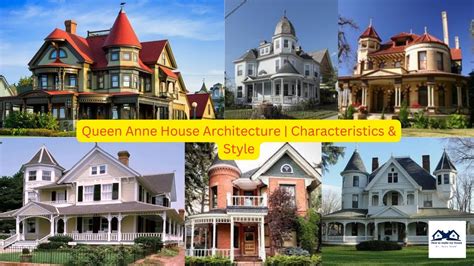The Queen Anne house style is one of the most recognizable and beloved architectural styles in the world, particularly in the United States and the United Kingdom. Emerging during the late 19th century, this style is named after Queen Anne, who ruled England from 1702 to 1714, although the architectural style itself does not directly reflect her era. Instead, it is a revival style that blends elements from various historical periods, including medieval, Tudor, and Colonial, with a distinctive emphasis on ornamentation and asymmetrical facades.
Origins and Evolution
The Queen Anne style gained popularity in the United States during the late 19th and early 20th centuries, particularly between 1880 and 1910. It was part of the broader Victorian era architectural trends, which sought to move away from the simplicity and minimalism of earlier styles. Architects and homeowners alike were drawn to the Queen Anne style for its eclecticism, allowing for a wide range of creative expressions and adaptations to different climates and regions.
Key Characteristics
Several key features distinguish the Queen Anne style from other architectural styles:
- Asymmetrical Facade: Queen Anne houses often have asymmetrical facades, with a mix of textures, materials, and shapes that create visual interest. This can include projecting bays, turrets, and porches.
- Multi-Story: These houses are typically multi-story, often two to three stories, with a prominent front facade that may feature a central front door surrounded by porches, balconies, and decorative elements.
- Steeply Pitched Roofs: Characterized by steeply pitched roofs, sometimes with multiple intersecting gables, these houses can have complex rooflines that add to their charm and functionality, allowing for additional living space in the attic.
- Decorative Trim and Detailing: Ornate woodwork, patterned masonry, and intricate metalwork are hallmarks of the Queen Anne style. Decorative elements can include carved wood, terracotta, and stained glass.
- Variety of Materials: The use of a variety of materials, such as brick, stone, clapboard, and shingles, adds to the style’s visual richness. Each material can be used in a way that highlights its unique texture and appearance.
- Turrets and Towers: The presence of turrets or towers, either round or square, is a distinctive feature of many Queen Anne houses, providing additional space and enhancing the exterior’s complexity and charm.
- Patterned Masonry and Half-Timbering: Some Queen Anne houses feature patterned masonry, where different colors or textures of brick or stone are arranged in decorative patterns. Half-timbering, where the frame of the house is exposed and filled with insets of brick, stone, or plaster, is also common.
Interior Characteristics
While the exterior of Queen Anne houses is notable for its ornateness, the interiors also have several characteristic features:
- Grand Entrance Halls: Often, the entrance hall of a Queen Anne house is grand, with a sweeping staircase and ornate woodwork.
- Fireplaces: Fireplaces, sometimes multiple per house, are common features. They are often decorated with intricate surrounds and mantels.
- Woodwork and Molding: Intricate woodwork, including wainscoting, paneling, and elaborate molding, is typical of Queen Anne interiors.
- Built-in Cabinetry: Built-in cabinetry and shelving add to the functionality and aesthetic appeal of the interior spaces.
Preservation and Appreciation
Today, many Queen Anne houses are recognized as historic landmarks and are cherished for their unique architectural contributions to neighborhoods and communities. Preservation efforts focus on maintaining the original character of these homes while ensuring they remain safe, functional, and energy-efficient for modern living.
Challenges in Modern Times
Despite their appeal, Queen Anne houses can present several challenges for modern homeowners, including:
- Energy Efficiency: The complex designs and older materials used in Queen Anne houses can make them less energy-efficient compared to modern constructions.
- Maintenance: The intricate detailing and variety of materials require regular maintenance to prevent decay and damage.
- Adaptation to Modern Needs: Incorporating modern amenities and open floor plans while preserving the historic integrity of the house can be a delicate balancing act.
Conclusion
The Queen Anne house style represents a peak in Victorian era eclecticism and ornamentation, offering a rich and varied architectural vocabulary that continues to inspire and delight. As a testament to the era’s architectural creativity and homeowners’ desire for unique and beautiful living spaces, Queen Anne houses remain beloved landmarks in many communities, symbolizing a blend of history, craftsmanship, and aesthetic appeal.
What are the key features of a Queen Anne house?
+Key features include asymmetrical facades, steeply pitched roofs, decorative trim and detailing, a variety of materials, and the presence of turrets or towers.
How did the Queen Anne style evolve over time?
+The Queen Anne style evolved as part of the broader Victorian architectural trends, blending elements from medieval, Tudor, and Colonial styles with an emphasis on ornamentation and asymmetry. It gained popularity in the late 19th and early 20th centuries in the United States and the United Kingdom.
What are the challenges of maintaining a Queen Anne house?
+Challenges include ensuring energy efficiency, maintaining the intricate detailing and variety of materials, and adapting the house to modern needs without compromising its historic integrity.
In conclusion, the Queen Anne house style is a unique and fascinating architectural phenomenon that reflects the creativity, craftsmanship, and historical influences of its time. Its enduring appeal is a testament to the power of architecture to inspire and to provide a sense of community and belonging. Whether as historic landmarks, family homes, or simply as objects of admiration, Queen Anne houses continue to captivate audiences and contribute to the rich tapestry of architectural heritage.



